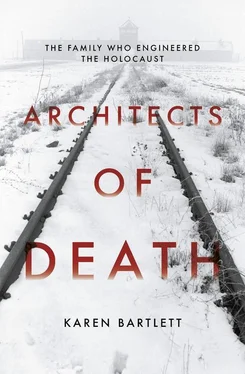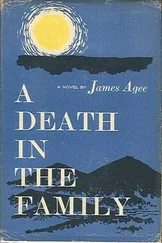In his defence, Ernst Wolfgang then told a further series of outright lies. He began by stating that his brother, Ludwig, who he said was ‘always open with me about his struggle with suicidal thoughts’, had never implied ‘any kind of connection between the ventilation and that “procedure”.’ Neither of the brothers had known any of the people responsible, either in the camps or in Berlin. ‘There was never even a single personal visit to Erfurt for the purposes of discussing the orders with us. They didn’t even know we existed.’ [137] Ibid.
Although evidence existed, the complicated course of Ernst Wolfgang’s tribunal demonstrates the difficulties of acquiring true information, especially working across different occupied zones, and with people and organisations that often had their own agendas in terms of protecting themselves or accusing others.
Ernst Wolfgang Topf’s tribunal began in December 1946 with an initial aim of obtaining sworn statements about him from two nonsuspect witnesses. In July 1947, the public prosecutor and president of the tribunal wrote to the SED (the Socialist Party of East Germany that would rule the DDR from 1948 until 1989) and the Erfurt police requesting information about the Topf brothers. A police employee, Kurt Ziegenbein, replied in August that year, reiterating that Ludwig Topf had committed suicide before questioning by the Allies and that Ernst Wolfgang had fled to the West. Both these events had occurred due to ‘installation of crematoria in all of Germany’s concentration camps at the behest of both brothers’. Ziegenbein added that the brothers had ‘definitely’ been ‘informed of what was happening in the camps’.
As a police officer, Ziegenbein had been a colleague of former Topf worker and ex-communist resistance member Bernhard Bredehorn, and former Topf fitter Heinrich Messing (Bredehorn had briefly been head of the police force in Erfurt, before being forced out in 1947, and Messing also occupied a prominent police position for a time). As such, Ziegenbein clearly knew where his loyalties lay, as he also stated that the Topf brothers had forced the workers to install the crematoria against their own wishes – and went on to make other, unproven allegations against Ernst Wolfgang. Contrary to all other reports, Ziegenbein said that Ernst Wolfgang had been a member of the Nazi Stormtroopers, the SA, involved in carrying out pogroms against the Jewish population of Erfurt and was a ‘200 per cent’ Nazi who liked to run around in a uniform.
When the denazification tribunal replied to the letter, asking for verification of these allegations, they waited several months before receiving a reply on 3 February 1948 that it was a case of mistaken identity with another Ernst Wolfgang Topf in Erfurt (there was no other Ernst Wolfgang Topf – the Erfurt police were clearly trying to seal the case against Ernst Wolfgang with false accusations).
A lack of interest and support for the denazification process meant that the tribunal was severely hampered by a lack of reliable information. The American-controlled document centre in Berlin replied to a request for information, but did not mention either of the two CIC investigations that had been conducted against Ernst Wolfgang. The Russian consulate, the mayor of Erfurt and the Erfurt police did not reply at all. In February 1948, the works council at the company that was once Topf and Sons replied to the tribunal, stating that the company had supplied crematoria for the concentration camps, but then added a series of allegations that the Topf brothers had been drunken brawlers, and had once hit each other with clubs in front of the workers.
In March 1948, the case against Ernst Wolfgang was passed on to the Wiesbaden tribunal, where he was now living, and the public prosecutor followed a new line of inquiry that Topf and Sons had developed and produced a mobile oven for Buchenwald. This mobile oven was illegal – and was perhaps the most incriminating evidence in the entire case presented against Ernst Wolfgang. By letter, a former Buchenwald prisoner, Werner Munchheimer said that he had read many times in his work with the Buchenwald camp construction department that the Topf company had built the cremation ovens. Munchheimer referred this to his former departmental head, Alfred Ingehag, who confirmed the company had installed static and mobile ovens, but this letter of 5 January 1950 was the last letter in the denazification file.
The advent of the cold war meant that, by 1948, the Americans had lost interest in pursuing the long-running denazification process – and it was wound up in 1950. In March that year the denazification case against Ernst Wolfgang Topf was dropped, because ‘the accused was only an ordinary member of the NSDAP from 1933, and never held any office or rank in the party’. [138] Ibid., p. 317. AS footnote 144: Chief Public Prosecutor at the Hessen-South Central Appeals Chamber to the Minister of Justice of the State of Hessen, 3 March 1950, Ministry of Justice of the State of Hessen, file ref. IV-538/50, sheet 1. The details of the winding-up of the Appeals Chamber process appear first in Kratz, Strategien der Verdrängung [PK: see above], p. 58.
By the end of the war 8.5 million Germans were members of the Nazi Party. Of that number, nearly one million (950,000) found themselves before a denazification tribunal. (The class makeup of the group in itself was interesting – nearly half of civil servants went before a tribunal, whereas only 3 per cent of workers did.) Yet the tribunals were placed under competing stresses from the beginning; all those who were assigned to the most serious categories were forbidden from engaging in anything other than ‘ordinary labour’ until the tribunal process was complete. As a result, the tribunals were torn between ‘the two equally pressing obligations of freeing the little Nazis from discrimination at the hands of the law, and punishing the big Nazis as quickly as possible’. [139] Detlef Junker, Philipp Gassert, Wilfried Mausbach, David B. Morris (eds), The United States and Germany in the Era of the Cold War 1945–1968, Cambridge University Press, 2004, p. 69.
At the end of the denazification tribunal process only 1,654 people were classified as category 1 – major offenders. A further 22,122 people were classified as category 2, while 106,422 people were deemed ‘less interested persons’. As one observer put it: ‘The system had run the sea through a sieve, in order to catch a couple of big fish.’ [140] Ibid.
One of those fish who had escaped the net was Ernst Wolfgang Topf. The denazification tribunal had failed to hold him to account just as it failed to hold many others to account. But the evidence of the illegal mobile oven at Buchenwald was sufficient for the public prosecutor to hand over Topf’s file to the criminal authorities. This time Topf faced a charge of accessory to murder.
Despite the severity of the charge, the criminal case proceeded with as much confusion and as many obstacles as all of the other attempts to hold the Topfs accountable for their actions. The Wiesbaden state prosecutor’s office opened file number 3Js 737/50 against Ernst Wolfgang Topf and, at the beginning of 1951, it wrote to the state prosecutor in Erfurt asking for information.
In Erfurt, however, a strange turn of events, meant that four Topf employees (now working for the renamed Topfwerke Erfurt VEB) were arrested on suspicion of crimes against humanity after a socialist party group within the company alleged that they had been seen burning sensitive documents relating to Topf and the SS in the steam-heating system – in the middle of summer.
The allegation itself was a strange one: why would anyone draw attention to themselves, by doing something so conspicuous, when they could have removed and disposed of the documents in a much more discreet way? The burned papers turned out to be personal documents, and the claim itself appears more like a trumped-up charge indicating a rift in the workforce, and the breakdown of the conspiracy of silence that had held strong at Topf since the end of the war, with former colleagues now turning on each other.
Читать дальше












